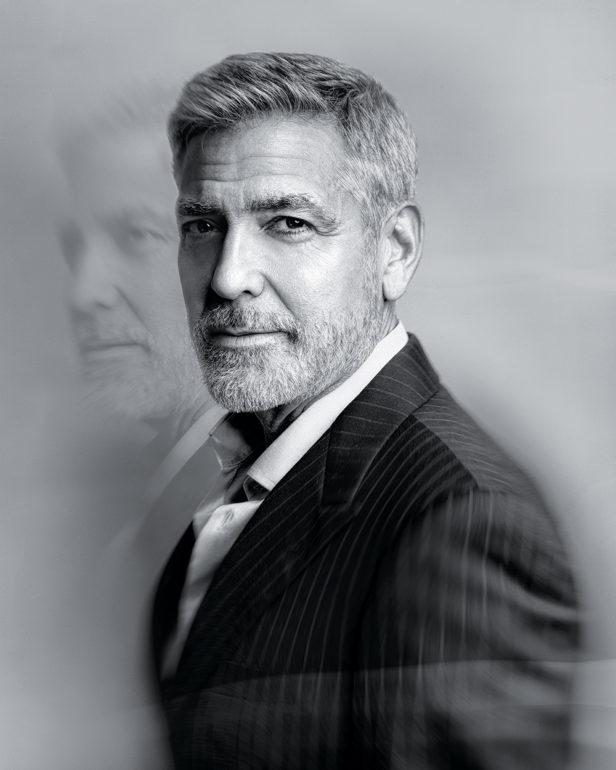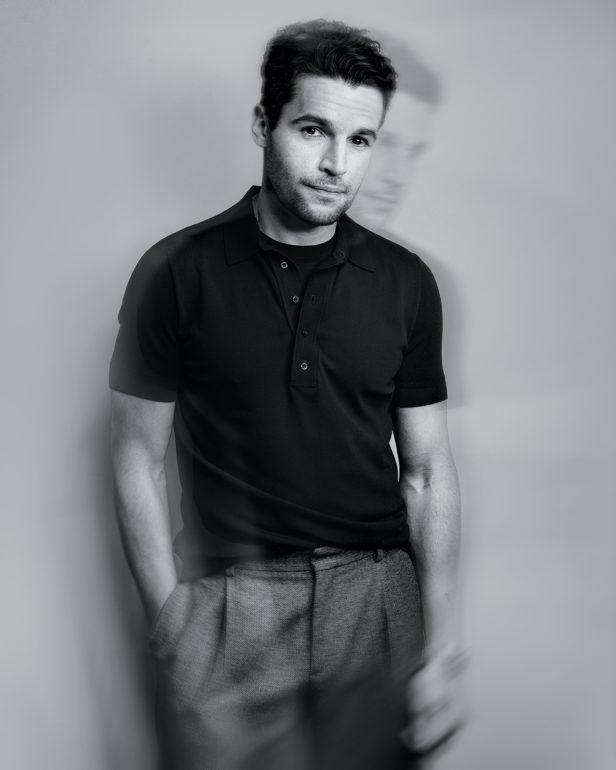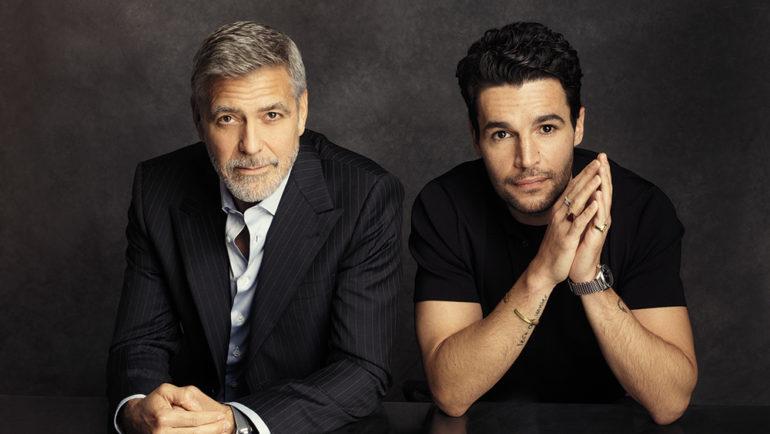How George Clooney and Christopher Abbott Battled to Bring ‘Catch-22’ Into the 21st Century
By Daniel Holloway
LOS ANGELES (Variety.com) – When Christopher Abbott walked into the audition room to read for the lead role in “Catch-22,” George Clooney greeted him wearing a leather helmet.
“I took a breath a little bit,” Abbott says. “I wasn’t as nervous. I was like, ‘All right, we can play.’”
The icebreaker worked. Abbott landed the role of Capt. John Yossarian, the bombardier antihero of Joseph Heller’s novel “Catch-22,” who spends the entirety of the story trying his damnedest to get out of World War II. The helmet was one of several that Clooney and producing partner Grant Heslov keep around their Smokehouse Pictures office in Los Angeles — relics from “Leatherheads,” the 2008 feature that was Clooney’s third outing as a director, which he calls “one of our big flops.”
With “Catch-22,” a limited series based on Heller’s 1961 book and set to premiere May 17 on Hulu, executive producer and director Clooney is flirting with the ghosts of flops past. Mike Nichols’ 1970 film adaptation, made during the Vietnam War, was a famous mess. Richard Dreyfuss starred as Yossarian three years later in a busted CBS pilot that tried to draft off the success of “MASH.” Even Heller’s sequel, the 1994 novel “Closing Time,” was shredded by critics. “Catch-22” is a classic of mid-20th-century American literature, but to try to recapture what made it so is to invite failure. And in the years since Hollywood last took a run at the book, American culture has shifted in such a way that the novel’s flaws — especially its blatant misogyny — can no longer be overlooked. If things go badly, Clooney could need the leather helmet when the show premieres.
Clooney and Heslov initially disliked the idea of taking a swing at yet another “Catch-22” adaptation. “You don’t want to take on famous novels because you can just get slaughtered for it,” Clooney says. But they fell in love with the script by Luke Davies and David Michôd, particularly the way it ironed out the book’s notorious nonlinear narrative. Equally important was how it reengineered the abhorrent portrayal of women in a book that, for example, refers to one of its only significant female characters as simply “Nately’s whore,” and another as “Nately’s whore’s kid sister.”
”Terrible” is how Clooney describes the novel’s depiction of women.
Clooney and Heslov also felt compelled to bring women into key creative positions on the project. Among their most important hires was Ellen Kuras, who directed two of the series’ six episodes; they split the directing duties on the other four.
“We tried to be part of the solution as opposed to being part of the problem,” says Clooney, who also has a minor role in the show — marking his first new TV-series appearance since “ER.”
Clooney and Heslov believe their version of “Catch-22” has another big thing going for it: . Blessed with leading-man looks and leading-man acting chops, Abbott is best known to audiences for his supporting role in HBO’s “Girls,” and less known for the handful of indie movies he’s made.
In “Catch-22,” Abbott makes Yossarian, whose so-called cowardice doesn’t square with the Greatest Generation image of World War II veterans, relatable and someone viewers can invest in. For the story to work, the audience has to want Yossarian not to perform some redeeming act of military heroism. It has to want him to abandon a just war.
“The most important part to us was casting Chris,” says Clooney, who made his star watch another Nichols film, 1971’s “Carnal Knowledge,” starring Jack Nicholson, in preparation. “Nicholson in ‘Carnal Knowledge’ does a lot of despicable things, but we still root for him somehow.” By Episode 6 of “Catch-22,” he adds, “we’ll have earned the right to really pull for Yossarian. But through that journey, he does some kind of crappy things. You have to, along the way, still root for him in the way you would Danny DeVito in ‘Taxi.’”
While Abbott is not widely recognized, he has been working steadily for almost 10 years. Clooney is not shy about how he sees the actor’s career trajectory, comparing him at one point to a young Sam Rockwell, whom Clooney directed in “Confessions of a Dangerous Mind” nearly two decades ago.
During a joint interview with Variety at the Langham Huntington hotel in Pasadena, Clooney pauses to ask Abbott how old he is, building to a compliment. The actor glances down at the tape recorder, then at Clooney, and waits a beat before answering: “I’m 33.”
Telling Abbott, “I was exactly your age when ‘ER’ hit,” Clooney adds that by his own account, he had appeared in 12 pilots and seven series prior to the NBC medical drama that would make him a star. “I’ve recognized a lot of things in Chris that I think are more mature than I had when I was his age, but the one thing where I see real similarity is in the way he can take this in stride and sort of be the captain of the ship. It was a big ship, and he had to be the captain of it. And he did it easily.”
“Catch-22” was shot over nearly five months last year in Italy. The series tells the story of Yossarian, a U.S. bombardier nervously flying through the tail end of the war in Europe, increasingly worried for his own skin as the fighting drags out despite the inevitability of Germany’s surrender. While the men above him — most importantly Kyle Chandler’s Colonel Cathcart — spend their time hatching careerist schemes, his peers keep dying. In Yossarian’s view, his American commanders and the German forces are engaged not in an epic clash of good against evil but in a collaborative effort to kill him. Desperate to live, he fakes illness, sabotages his missions and repeatedly tries to have himself declared crazy and unfit for combat. The catch — or Catch-22, as it is described (in this case by Heslov in an on-camera role as the squadron’s doctor) — is that it’s the act of a sane person to ask to leave combat, thus anyone who does so is not unfit and must remain on combat duty.
“He’s the kind of person who’s always looking at the sky during a storm, and watching for lightning to strike,” Abbott says. “What happens is lightning is striking all these people around him, and he’s constantly trying to dodge it any way he can.”
Because “Catch-22” is so focused on Yossarian, Abbott is almost always on-screen. Though he shares billing with veterans Chandler, Clooney, Heslov and Hugh Laurie, as well as a gaggle of younger actors, Abbott bore outsize pressure during shooting.
Clooney recalls that often there would be no time between scenes for Abbott to return to his trailer and change clothes. Instead, his wardrobe would be brought to set. Abbott would dress in one of the tents that made up the squadron’s on-camera camp, then step out and start filming a new scene, sometimes under the guidance of a different director from the one he’d been working with minutes earlier.
“When the right guy walks in the room, it’s such a relief,” Heslov says. “You just feel like a big weight has been lifted off your shoulders. And it happens — once in a while it happens — and it happened on this one.”
Clooney was originally supposed to do the lion’s share of the directing and also signed on to play Cathcart, the meatiest of the officer roles. With that level of commitment, “Catch-22” became more than an ambitious adaptation of a challenging literary work. It became ’s Return to TV.
“He’s the kind of person who’s always looking at the sky during a storm, and watching for lightning to strike. … Lightning is striking all these people around him, and he’s constantly trying to dodge it any way he can.”
Christopher abbott
Studio Paramount Television had no problem finding a buyer for that package.
“We want to be a home for top talent,” says head of original series Craig Erwich. “George Clooney is certainly a top talent. So this was an incredible opportunity to do business with somebody you’d want to do business with.”
But before production began, Clooney’s thinking shifted. The prospect of producing the series and directing most of it while also taking on its second-biggest role seemed less than realistic. He switched parts from Cathcart to Lieutenant Scheisskopf, a minor character whose defining traits are loving parades and failing to sexually satisfy his wife.
Although he only appears in three episodes, Clooney gets satisfyingly hammy moments as Scheisskopf, who wants nothing other than for his men to march well. Chandler, who stepped into the role of Cathcart, Yossarian’s principal adversary, does the critical job of locking in the show’s absurd tone with his inspired decision to play the character as fencepost-dumb.
To mount a successful “Catch-22” in the 21st century, the way women were represented had to be more than tweaked. It had to be overhauled.
“We made it our mission statement to make the portrayal of women more interesting,” Davies says. “And not because we think the world has changed, not because we think that outside forces tell us that we need to do that, but because the portrayal of women in the novel is so goddamn awful that it just gave usthe heebie-jeebies.”
In the book, Yossarian’s relationship with Nurse Duckett is rooted in no-strings sex, and ends without consequence for the sake of a joke about women wanting to marry doctors. As played by Tessa Ferrer, the series’ version of Duckett is a more complex character, one whose relationship with Abbott’s Yossarian threatens to flower into something substantial.
“When people ask me, how does it feel being in a story about a bunch of guys, in my thoughts I’m like, I never really saw the story that way,” Kuras says. “I always see it as a story that’s more universal, that’s about all of us.”
But the story is quite literally about a bunch of guys. And in the prestige television space, the series creators exploring the kinds of characters whose stories have been traditionally under-told — such as Ryan Murphy with “Pose,” Donald Glover with “Atlanta,” and most recently Alexandra Rushfield with “Shrill” — have stood out best of late. There are moments, particularly the many in which the camera rests on a dozen or so shirtless young white men, when “Catch-22” feels very much of the 20th century.
But then there are scenes that feel scary contemporary. The critique of capitalism through the character of black-market kingpin Milo Minderbinder — played by Daniel David Stewart, a ringer for a young Ron Howard — jibes well with the emergence of proudly self-identified socialists in American politics. And if there were ever a time for a tale about the absurd horrors wrought by craven, inept leaders, that time is now.
“This show speaks to how a lot of people might be feeling about the current climate, being caught up in an insane bureaucracy,” says Paramount TV president Nicole Clemens. “So it’s timely, even though it’s set in World War II.”
Clooney resists the idea that something “designed as an entertainment” needs to correlate with current events. But, he concedes: “Wherever you stand on the political spectrum, everybody wakes up and feels that there is some dark cloud sort of looming over you. Yossarian every morning wakes up feeling that way.”
As originally conceived by Heller, Yossarian is a neurotic. In the hands of Abbott, he doesn’t become any less that, but he does become a neurotic you can better empathize with. His responses to the terrors happening around him seem not as extreme as they might be in the hands of another actor. They start to seem plausible.
Part of that is experience, which Abbott now has enough of to tackle a role like this. “By the time this came along, I was, of course, nervous, and excited,” he says. “But at the same time, I was ready. I’m completely ready for it.”
Clooney thinks so too.
“There’s an interesting thing that happens for a young actor when they get to be his age, which is they go from being just the younger man to actually the leading man, and it changes very quickly,” Clooney says. “And funnily enough, there aren’t many of them. We look high and low for them all the time. I feel like whatever happens with this, the one thing that will come out of it is an incredible leading man.”
Having just had George Clooney drape the mantel of American leading manhood upon him, Abbott smiles.
“I’m here to stop all these Brits,” he says.
Clooney nods.
“Somebody has to. I see you doing it.”



